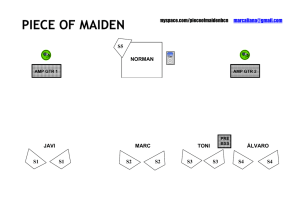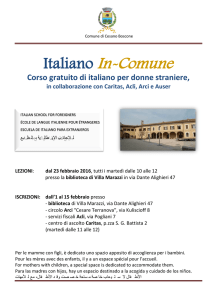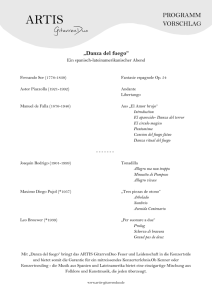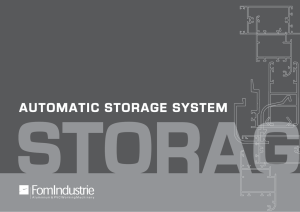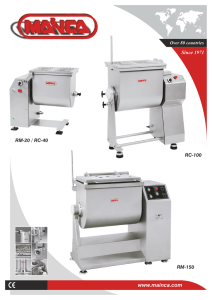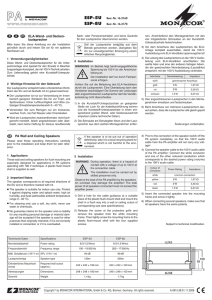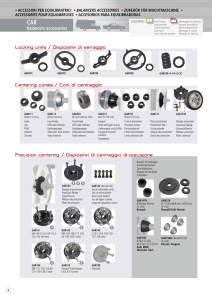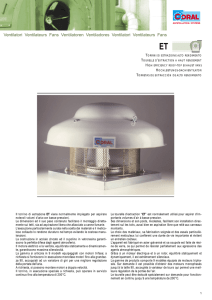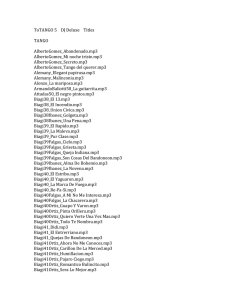ELA-Mischverstärker mit MP3-Spieler PA Mixing Amplifier with MP3
Anuncio
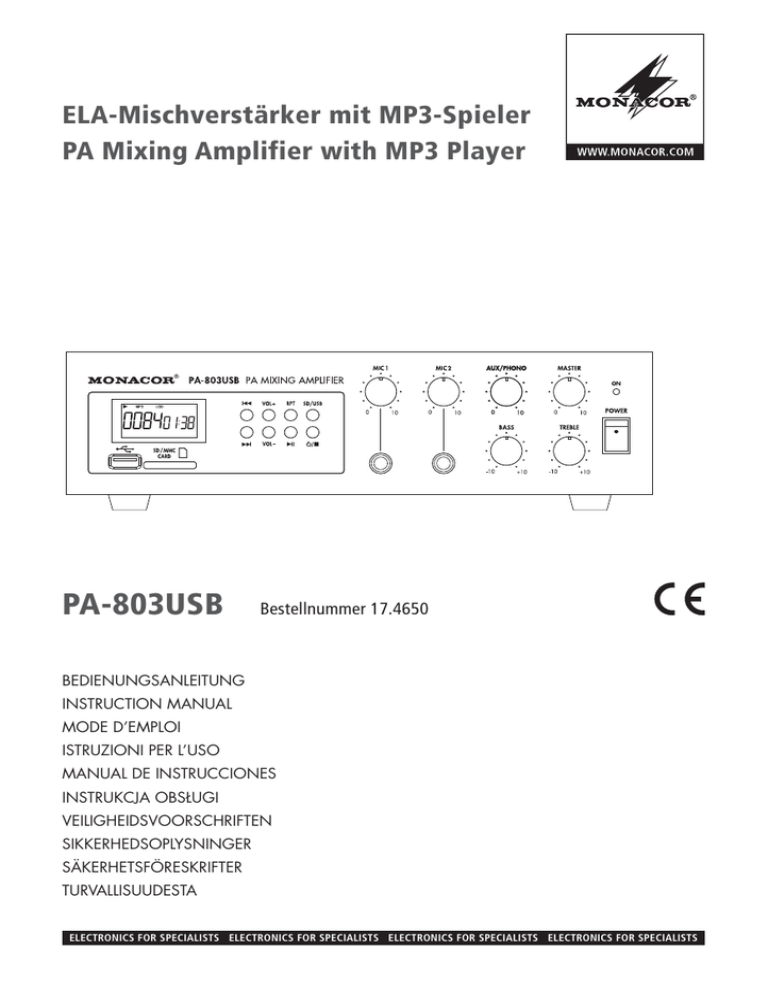
ELA-Mischverstärker mit MP3-Spieler PA Mixing Amplifier with MP3 Player PA-803USB Bestellnummer 17.4650 BEDIENUNGSANLEITUNG INSTRUCTION MANUAL MODE D’EMPLOI ISTRUZIONI PER L’USO MANUAL DE INSTRUCCIONES INSTRUKCJA OBSŁUGI VEILIGHEIDSVOORSCHRIFTEN SIKKERHEDSOPLYSNINGER SÄKERHETSFÖRESKRIFTER TURVALLISUUDESTA ELECTRONICS FOR SPECIALISTS ELECTRONICS FOR SPECIALISTS ELECTRONICS FOR SPECIALISTS ELECTRONICS FOR SPECIALISTS Deutsch . . . . . . . . . . . . . . . . . . Seite 4 English . . . . . . . . . . . . . . . . . . . Page 6 Français . . . . . . . . . . . . . . . . . . Page 8 Italiano . . . . . . . . . . . . . . . . . . Pagina 10 Español . . . . . . . . . . . . . . . . . . Página 12 Polski . . . . . . . . . . . . . . . . . . . . Strona 14 Nederlands . . . . . . . . . . . . . . . Pagina 16 Dansk . . . . . . . . . . . . . . . . . . . . Sida 16 Svenska . . . . . . . . . . . . . . . . . . Sidan 17 Suomi . . . . . . . . . . . . . . . . . . . . Sivulta 17 ELECTRONICS FOR SPECIALISTS ELECTRONICS FOR SPECIALISTS ELECTRONICS FOR SPECIALISTS ELECTRONICS FOR SPECIALISTS 2 1 8 9 17 18 19 3a 3 2 3 4 10 11 12 13 14 20 21 3b 5 6 15 22 23 24 7 16 25 1 2 Deutsch ELA-Mischverstärker mit MP3-Spieler Bitte lesen Sie diese Anleitung vor dem Betrieb gründlich durch und heben Sie sie für ein späteres Nachlesen auf. Auf der ausklappbaren Seite 3 finden Sie alle beschriebenen Bedienelemente und Anschlüsse. Die Lautsprecher dürfen nur von Personen, die ausreichende Fachkenntnisse in der 100-V-Beschallungstechnik besitzen, angeschlossen werden (Kap. 4.2, Pos. 21 und 22). Die Bedienung des Verstärkers ist einfach und auf erwachsene Nichtfachleute ausgerichtet. Treten jedoch Fragen auf, wenden Sie sich bitte an Ihren Installateur oder Fachhändler. 1 Hinweise für den sicheren Gebrauch Das Gerät entspricht allen relevanten Richtlinien der EU und ist deshalb mit gekennzeichnet. WARNUNG Das Gerät wird mit lebensgefährlicher Netzspannung versorgt. Nehmen Sie deshalb nie selbst Eingriffe am Gerät vor und stecken Sie nichts durch die Lüftungsöffnungen! Es besteht die Gefahr eines elektrischen Schlages. Im Betrieb liegt an den Lautsprecheranschlüssen (21) berührungsgefährliche Spannung bis 100 V an. Den Verstärker nie ohne die Abdeckung (22) betreiben. Führen Sie alle Anschlüsse nur bei ausgeschaltetem Verstärker durch. 4 G Das Gerät ist nur zur Verwendung im Innenbereich geeignet. Schützen Sie es vor Tropf- und Spritzwasser, hoher Luftfeuchtigkeit und Hitze (zulässiger Einsatztemperaturbereich 0 – 40 °C). G Stellen Sie keine mit Flüssigkeit gefüllten Gefäße, z. B. Trinkgläser, auf das Gerät. G Ziehen Sie sofort den Netzstecker aus der Steckdose, 1. wenn sichtbare Schäden am Gerät oder am Netzkabel vorhanden sind, 2. wenn nach einem Sturz oder Ähnlichem der Verdacht auf einen Defekt besteht, 3. wenn Funktionsstörungen auftreten. Geben Sie das Gerät in jedem Fall zur Reparatur in eine Fachwerkstatt. G Ziehen Sie den Netzstecker nie am Kabel aus der Steckdose, fassen Sie immer am Stecker an. G Verwenden Sie für die Reinigung nur ein trockenes, weiches Tuch, niemals Wasser oder Chemikalien. G Wird das Gerät zweckentfremdet, nicht richtig angeschlossen, falsch bedient oder nicht fachgerecht repariert, kann keine Haftung für daraus resultierende Sach- oder Personenschäden und keine Garantie für das Gerät übernommen werden. Soll das Gerät endgültig aus dem Betrieb genommen werden, übergeben Sie es zur umweltgerechten Entsorgung einem örtlichen Recyclingbetrieb. 2 Einsatzmöglichkeiten Der Verstärker PA-803USB mit integriertem MP3Spieler und einer Sinusausgangsleistung von 30 W ist z. B. für den Einsatz in kleinen ELA-Anlagen geeignet. Neben dem Netzbetrieb ist auch ein 12-VBetrieb möglich (z. B. mit einer Autobatterie), sodass er sich auch für mobile Einsätze eignet. Es können entweder 100-V-Lautsprecher oder Niederohmlautsprecher (Impedanz min. 4 Ω) verwendet werden (siehe Abb. 3a und 3b). Der Verstärker ist mit 3 Eingängen ausgestattet: – Mikrofoneingang MIC 1 für wichtige Durchsagen mit Vorrang vor allen anderen Eingängen, d. h. sobald ein Signal an dem Eingang anliegt, werden die Signale der anderen Eingänge ausgeblendet (Auto-Talkover) – Mikrofoneingang MIC 2 – Eingang AUX/PHONO z. B. für CD-Spieler, Radio, Tape-Deck oder Plattenspieler 3 Aufstellen des Verstärkers Der Verstärker lässt sich als Tischgerät aufstellen oder mit den beiliegenden Montagewinkeln, die seitlich am Gehäuse festgeschraubt werden, an geeigneter Stelle befestigen, z. B. unter einem Regal. In jedem Fall muss Luft ungehindert durch alle Lüftungsöffnungen strömen können, damit der Verstärker ausreichend gekühlt wird. 4 Bedienelemente und Anschlüsse 4.1 Vorderseite 1 Display des MP3-Spielers: Zeigt die Titelnummer und die bereits gespielte Zeit eines Titels an 2 Taste RPT zum Umschalten zwischen: – ständiger Wiederholung aller Titel Anzeige: REP ALL – Wiederholung des laufenden Titels Anzeige: REP 1 – Abspielen der Titel in zufälliger Folge Anzeige: A – keiner Wiederholfunktion Anzeigen REP und A ausgeblendet 3 Taste SD / USB zum Umschalten zwischen USBStick und SD/ MMC-Karte 4 Lautstärkeregler MIC 1 und MIC 2 für an den darunterliegenden Buchsen angeschlossene Mikrofone 1Hinweis: Aufgrund der Vielfalt von Speicher-Herstellern und Gerätetreibern kann nicht garantiert werden, dass alle Speichermedien mit dem MP3-Spieler kompatibel sind. 10 Tasten und zum Anwählen des vorherigen bzw. nächsten Titels 11 Tasten VOL+ und VOL- für die Lautstärke des MP3-Spielers 12 Taste zum Wechseln zwischen Wiedergabe und Pause 13 Taste zum Ein- und Ausschalten des MP3Spielers (die Taste gedrückt halten, bis das Display aufleuchtet bzw. erlischt) und zum Beenden des Abspielens (die Taste kurz drücken) 14 Buchsen MIC 1 und MIC 2 (6,3-mm-Klinke, asym.) zum Anschluss von Mikrofonen Der Eingang MIC 1 hat eine Auto-TalkoverFunktion (siehe Kap. 2). 15 Klangregler BASS (±10 dB/100Hz) und TREBLE (±10 dB / 10 kHz) 16 Ein- /Ausschalter POWER Hinweise: Nach dem Einschalten startet automatisch der MP3-Spieler, wenn ein USB-Stick oder eine SD/ MMC-Karte eingesteckt ist. Beim Betrieb mit 12 V über die Anschlüsse DC INPUT (20) ist der Schalter POWER ohne Funktion. 4.2 Rückseite 17 Netzbuchse zum Anschluss an eine Steckdose (230 V~/50 Hz) über das beiliegende Netzkabel 18 Halterung für die Netzsicherung Eine geschmolzene Sicherung nur durch eine gleichen Typs ersetzen. 19 Masseanschluss, z. B. für einen Plattenspieler 20 Anschlussklemmen DC INPUT für den 12-V-Betrieb oder für eine 12-V-Notstromversorgung 21 Lautsprecheranschlüsse Entweder 100-V-Lautsprecher an die Klemmen „100 V“ und „COM“ anschließen (Abb. 3a); der Verstärker darf mit maximal 30 W Sinus durch die Lautsprecher belastet werden, anderenfalls kann er beschädigt werden oder einen Lautsprecher bzw. eine Lautsprechergruppe mit einer Gesamtimpedanz von mindestens 4 Ω an die Klemmen „4 Ω“ und „COM“ anschließen. Die Abbildung 3b zeigt verschiedene Arten, die Mindestimpedanz einzuhalten. Es gibt aber noch weitere Möglichkeiten. 22 Abdeckung für die Anschlussklemmen Deutsch 5 Lautstärkeregler AUX / PHONO für ein an den Buchsen AUX / PHONO (24) angeschlossenes Gerät 6 Regler MASTER für die Gesamtlautstärke 7 Betriebsanzeige 8 USB-Buchse zum Einstecken eines USB-Sticks1 9 Steckplatz für eine SD/ MMC-Speicherkarte1 (max. 32 GB) Beim Einstecken der Karte muss die abgeschrägte Ecke nach rechts und zum Gerät zeigen. Soll die Karte wieder entnommen werden, sie etwas hineindrücken, sodass sie ausrastet. WARNUNG Den Verstärker nie ohne die Abdeckung betreiben. Anderenfalls besteht bei Berührung der Anschlüsse die Gefahr eines elektrischen Schlages. 23 Durchschleifanschlüsse PRE OUT und AMP IN zur externen Klangbeeinflussung z. B. durch einen Equalizer Den Eingang z. B. des Equalizers an die Buchse PRE OUT anschließen und den Ausgang an die Buchse AMP IN. Hinweis: Der Verstärker gibt kein Signal ab, wenn das eingeschleifte Gerät ausgeschaltet, defekt oder falsch angeschlossen ist. Wenn kein Gerät angeschlossen ist, muss die Steckbrücke in die Buchsen gesteckt werden. 24 Cinch-Buchsen zum Anschluss eines Geräts mit Line-Ausgang (CD-Spieler, Radio, TapeDeck) oder eines Plattenspielers 25 Umschalter für den Eingang AUX / PHONO (24): Position AUX für ein Gerät mit Line-Ausgang Position PHONO für einen Plattenspieler 5 Technische Daten Sinus-Ausgangsleistung: . Klirrfaktor: . . . . . . . . . . . . Frequenzbereich: . . . . . . . Eingangsempfindlichkeit der Audioeingänge MIC 1 und MIC 2: . . . . . AUX / PHONO: . . . . . . . 30 W < 1% 80 – 18 000 Hz, ±3 dB 3 mV 500 mV/ 3 mV (RIAA) umschaltbar Lautsprecherausgänge: . . 4 Ω, 25 V, 70 V, 100 V Störabstand MIC 1 und MIC 2: . . . . . > 65 dB AUX: . . . . . . . . . . . . . . > 75 dB PHONO: . . . . . . . . . . . . > 55 dB Stromversorgung Netzspannung: . . . . . . . 230 V~ / 50 Hz Leistungsaufnahme: . . max. 100 VA Gleichstromversorgung: 12 V, max. 5 A Abmessungen: . . . . . . . . . 280 × 75 × 230 mm Gewicht: . . . . . . . . . . . . . . 4,2 kg Änderungen vorbehalten. Diese Bedienungsanleitung ist urheberrechtlich für MONACOR ® INTERNATIONAL GmbH & Co. KG geschützt. Eine Reproduktion für eigene kommerzielle Zwecke – auch auszugsweise – ist untersagt. 5 English PA Mixing Amplifier with MP3 Player Please read these instructions carefully prior to operation and keep them for later reference. All operating elements and connections described can be found on the fold-out page 3. Connection of the speakers (chapter 4.2, items 21 and 22) requires adequate technical knowledge in 100 V PA technology and is to be made by experts only. Operation of the amplifier is easy, even for adults without any expert knowledge. However, in case of any queries, please contact your installer or retailer. 1 Safety Notes The unit corresponds to all relevant directives of the EU and is therefore marked with . WARNING The unit is supplied with hazardous mains voltage. Leave servicing to skilled personnel only and do not insert anything into the air vents! Inexpert handling or modification of the unit may cause an electric shock hazard. During operation, there is a hazard of contact at the speaker terminals (21) with a dangerous voltage up to 100 V. Always fold down the protective cover (22) when operating the amplifier. Always switch off the amplifier before making any connection. G The unit is suitable for indoor use only. Protect it against dripping water and splash water, high air humidity and heat (admissible ambient temperature range 0 – 40 °C). G Do not place any vessels filled with liquid, e. g. drinking glasses, on the unit. G Immediately disconnect the mains plug from the mains socket if 1. there is visible damage to the unit or to the mains cable, 2. a defect might have occurred after a drop or similar accident, 3. malfunctions occur. The unit must in any case be repaired by skilled personnel. 6 G Never pull the mains cable to disconnect the mains plug from the mains socket, always seize the plug. G For cleaning only use a dry, soft cloth, never use chemicals or water. G No guarantee claims for the unit and no liability for any resulting personal damage or material damage will be accepted if the unit is used for other purposes than originally intended, if it is not correctly connected or operated, or not repaired in an expert way. If the unit is to be put out of operation definitively, take it to a local recycling plant for a disposal which is not harmful to the environment. 2 Applications The amplifier PA-803USB with integrated MP3 player and an RMS output power of 30 W is e. g. suitable for the use in small PA systems. In addition to the mains operation, also a 12 V operation is possible (e. g. with a car battery) so that it is also suitable for mobile applications. Either use 100 V speakers or low impedance speakers (minimum impedance 4 Ω) [see figs. 3a and 3b]. The amplifier is equipped with 3 inputs: – Microphone input MIC 1 for important announcements taking priority over all other inputs, i. e. with a signal present at the input, the signals of the other inputs will be faded out (automatic talkover) – Microphone input MIC 2 – Input AUX / PHONO e. g. for CD player, radio, tape deck or turntable 3 Setting Up the Amplifier The amplifier can be set up as a tabletop unit or be fixed at a suitable place, e. g. below a shelf, by means of the supplied mounting brackets which are laterally screwed to the housing. In order to ensure a sufficient cooling of the amplifier, air must always be able to flow freely through all air vents. 4 Operating Elements and Connections 4.1 Front panel 1 Display of the MP3 player: Shows the title number and the time already played of a title 2 Button RPT to switch between: – Continuous repeat of all titles indication: REP ALL – Repeat of the current title indication REP 1 – Replay of the titles in a random order indication: A – No repeat function indications REP and A extinguished 4 Volume controls MIC 1 and MIC 2 for microphones connected to the jacks below 5 Volume control AUX / PHONO for a unit connected to the jacks AUX / PHONO (24) 6 Control MASTER for the overall volume 7 Power indication 8 USB jack for inserting a USB memory stick1 9 Slot for an SD / MMC memory card1 (max. 32 GB) When inserting the card, the bevelled edge must point to the right and to the unit. To remove the card, slightly press it into the slot so that it disengages. 1Note: Due to the large number of storage device manufacturers and device drivers, it cannot be guaranteed that all storage media are compatible with the MP3 player. 10 Buttons next title and to select the previous or the 11 Buttons VOL+ and VOL- for the volume of the MP3 player 12 Button pause to change between reproduction and 13 Button to switch the MP3 player on and off (keep the button pressed until the display lights up or extinguishes) and to stop the playing (shortly press the button) 14 Jacks MIC 1 and MIC 2 (6.3 mm jack, unbal.) for connection of microphones The input MIC 1 has an automatic talkover function (see chapter 2) 15 Tone controls BASS (±10 dB / 100Hz) and TREBLE (±10 dB / 10 kHz) 16 POWER switch Notes: After switching-on, the MP3 player starts automatically when a USB memory stick or an SD / MMC card is inserted. For 12 V operation via the connections DC INPUT (20) the switch POWER has no function. 4.2 Rear panel 17 Mains jack for connection to a socket (230 V~/ 50 Hz) via the mains cable provided 18 Support for the mains fuse. Always replace a blown fuse by one of the same type. 19 Ground connection, e. g. for a turntable be loaded by the speakers with 30 W RMS as a maximum, otherwise it may be damaged or connect a speaker or a speaker group with a total impedance of 4 Ω as a minimum to the terminals “4 Ω” and “COM”. Fig. 3b shows various ways to keep the minimum impedance. However, there are also other possibilities. 22 Cover for the terminals WARNING English 3 Button SD / USB to switch over between USB memory stick and SD / MMC card Never operate the amplifier without cover. Otherwise you will risk an electric shock when touching the terminals. 23 Feed-through connections PRE OUT and AMP IN for external sound effect, e. g. by an equalizer Connect the input e. g. of the equalizer to the jack PRE OUT and the output to the jack AMP IN. Note: The amplifier does not give any signal when the unit inserted is switched off, if it is defective or not correctly connected. When no unit has been connected, the jumper must be connected to the jacks. 24 RCA jacks for connection of a unit with line output (CD player, radio, tape deck) or a turntable 25 Selector switch for the input AUX / PHONO (24): Position AUX for a unit with line output Position PHONO for a turntable 5 Specifications RMS output power: . . . . . 30 W THD: . . . . . . . . . . . . . . . . < 1 % Frequency range: . . . . . . 80 – 18 000 Hz, ±3 dB Input sensitivity of the audio inputs MIC 1 and MIC 2: . . . . . 3 mV AUX / PHONO: . . . . . . . 500 mV/ 3 mV (RIAA), switchable Speaker outputs: . . . . . . . 4 Ω, 25 V, 70 V, 100 V S / N ratio MIC 1 and MIC 2: . . . . . > 65 dB AUX: . . . . . . . . . . . . . . > 75 dB PHONO: . . . . . . . . . . . . > 55 dB Power supply Mains voltage: . . . . . . . 230 V~ / 50 Hz Power consumption: . . max. 100 VA DC power supply: . . . . 12 V, max. 5 A Dimensions: . . . . . . . . . . . 280 × 75 × 230 mm Weight: . . . . . . . . . . . . . . 4.2 kg 20 Terminals DC INPUT for 12 V operation or for a 12 V emergency power supply Subject to technical modifications. 21 Speaker connections Either connect 100 V speakers to the terminals “100 V” and “COM” (fig. 3a); the amplifier may All rights reserved by MONACOR ® INTERNATIONAL GmbH & Co. KG. No part of this instruction manual may be reproduced in any form or by any means for any commercial use. 7 Français Amplificateur mixeur Public Adress avec lecteur MP3 Veuillez lire la présente notice avec attention avant le fonctionnement et conservez-la pour pouvoir vous y reporter ultérieurement. Vous trouverez sur la page 3, dépliable, les éléments et branchements décrits. Seules des personnes ayant des connaissances suffisantes en ligne 100 V peuvent installer les enceintes (chapitre 4.2, positions 21 et 22). Lʼutilisation de lʼamplificateur est simple et prévue pour des adultes non techniciens. Cependant, en cas de questions, contactez votre installateur ou revendeur. 1 Conseils dʼutilisation et de sécurité Lʼappareil répond à toutes les directives nécessaires de lʼUnion européenne et porte donc le symbole . AVERTISSEMENT Lʼappareil est alimenté par une tension dangereuse. Ne touchez jamais lʼintérieur de lʼappareil et ne faites rien tomber dans les ouïes de ventilation car en cas de mauvaise manipulation, il y a risque de décharge électrique. Pendant le fonctionnement, une tension dangereuse jusquʼà 100 V est présente aux bornes haut-parleurs (21). Faites fonctionner lʼamplificateur uniquement lorsque le cache de protection (22) est fermé. Effectuez les branchements uniquement lorsque lʼamplificateur est éteint. G Lʼappareil nʼest conçu que pour une utilisation en intérieur. Protégez-le des éclaboussures, de tout type de projections dʼeau, dʼune humidité dʼair élevée et de la chaleur (température ambiante admissible 0 – 40 °C). G En aucun cas, vous de devez poser dʼobjets contenant du liquide, ou par exemple un verre, sur lʼappareil. G Débranchez le cordon secteur immédiatement dans les cas suivants : 1. lʼappareil ou le cordon secteur présente des dommages visibles, 2. après une chute ou un accident similaire, vous avez un doute sur lʼétat de lʼappareil. 3. des dysfonctionnements apparaissent. Dans tous les cas, les dommages doivent être réparés par un technicien spécialisé. G G Ne débranchez pas lʼappareil en tirant sur le cordon secteur : retirez toujours le cordon secteur en tirant la fiche. Pour le nettoyage, utilisez un chiffon sec et doux, en aucun cas de produits chimiques ou dʼeau. G Nous déclinons toute responsabilité en cas de dommages corporels ou matériels résultants si 8 lʼappareil est utilisé dans un but autre que celui pour lequel il a été conçu, sʼil nʼest pas correctement branché, utilisé ou réparé par une personne habilitée ; en outre, tout droit à la garantie deviendrait caduque. Lorsque lʼappareil est définitivement retiré du service, vous devez le déposer dans une usine de recyclage de proximité pour contribuer à son élimination non polluante. 2 Possibilités dʼutilisation Lʼamplificateur PA-803USB avec lecteur MP3 intégré et une puissance de sortie RMS de 30 W est adapté par exemple pour une utilisation dans de petites installations Public Adress. En plus du fonctionnement sur secteur, un fonctionnement en 12 V est possible (par exemple avec une batterie de voiture) ; il est donc particulièrement bien adapté pour des applications mobiles. Il est possible de relier des haut-parleurs 100 V ou des haut-parleurs basse impédance (impédance minimale 4 Ω) [voir schémas 3a et 3b]. Lʼamplificateur est équipé de 3 entrées : – entrée micro MIC1 pour des annonces importantes avec priorité sur toutes les autres entrées, cʼest-à-dire que dès quʼun signal est présent à lʼentrée, les signaux des autres entrées sont coupés (auto-talkover). – entrée micro MIC 2 – entrée AUX/PHONO par exemple pour lecteur CD, radio, tape-deck ou platine disque 3 Positionnement de lʼamplificateur Lʼamplificateur peut être posé directement sur une table ou fixé à un endroit voulu, par exemple sous une étagère, via les étriers de montage livrés, vissables sur les côtés du boîtier. Dans ce cas, lʼair doit pouvoir circuler librement via toutes les ouïes de ventilation pour que lʼamplificateur soit suffisamment refroidi. 4 Eléments de commande et branchements 4.1 Face avant 1 Affichage du lecteur MP3 : indique le numéro du titre et la durée déjà lue du titre 2 Touche RPT pour commuter entre : – répétition continue de tous les titres affichage : REP ALL – répétition du titre en cours affichage : REP 1 – lecture des titres en ordre aléatoire affichage : A – pas de fonction répétition affichages REP et A non visibles 1Conseil : en raison de la multitude de fabricants de cartes mémoires et de drivers dʼappareils, il nʼest pas possible de garantir que tous les supports de mémoire soient compatibles avec le lecteur MP3. 10 Touches et pour sélectionner le titre précédent ou suivant 11 Touches VOL+ et VOL- pour le volume du lecteur MP3 12 Touche pour commuter entre lecture et pause 13 Touche pour allumer et éteindre le lecteur MP3 (maintenez la touche enfoncée jusquʼà ce que lʼaffichage brille ou sʼéteigne) et pour arrêter la lecture (appuyez brièvement sur la touche) 14 Prises MIC 1 et MIC 2 (jack 6,35, asym) pour brancher des microphones Lʼentrée MIC 1 a une fonction auto talkover (voir chapitre 2) 15 Réglages de tonalité BASS (±10 dB / 100Hz) et TREBLE (±10 dB / 10 kHz) 16 Interrupteur secteur POWER Conseils : une fois allumé, le lecteur MP3 démarre automatiquement si une clé USB ou une carte SD/MMC est insérée. Pour un fonctionnement 12 V via les branchements DC INPUT (20), lʼinterrupteur POWER nʼa pas de fonction. 4.2 Face arrière 17 Prise secteur pour brancher à une prise 230 V~/ 50 Hz via le cordon secteur livré 18 Porte-fusible : tout fusible fondu doit impérativement être remplacé par un fusible de même type. 19 Branchement masse, par exemple pour une platine disque 20 Bornes de branchement DC INPUT pour le fonctionnement 12 V ou pour une alimentation de secours 12 V 21 Bornes haut-parleurs Reliez soit des haut-parleurs 100 V aux bornes “100 V” et “COM” (schéma 3a) ; lʼamplificateur doit avoir une charge maximale de 30 WRMS par les haut-parleurs sinon il peut être endommagé. Soit un haut-parleur ou un groupe de haut-parleurs avec une impédance totale de 4 ohms au moins aux bornes “4 Ω” et “COM”. Le schéma 3b présent différents moyens pour conserver lʼimpédance minimale. Il existe cependant dʼautres possibilités. 22 Cache pour les bornes de branchement Français 3 Touche SD / USB pour commuter entre clé USB et carte SD / MMC 4 Réglages de volume MIC1 et MIC2 pour des microphones reliés aux prises placées en dessous 5 Réglage de volume AUX / PHONO pour un appareil branché aux prises AUX / PHONO (24) 6 Réglage MASTER pour le volume général 7 Témoin de fonctionnement 8 Port USB pour brancher une clé USB1 9 Fente pour une carte mémoire SD / MMC1 (32 GO max.) Lorsque vous insérez la carte mémoire, le coin oblique doit être vers la droite et dirigé vers lʼappareil. Pour retirer la carte, appuyez dessus pour quʼelle se désenclenche. AVERTISSEMENT Ne faites jamais fonctionner lʼamplificateur sans le cache. Sinon, il y a risque de décharge électrique si vous touchez les branchements. 23 Branchements pour repiquage PRE OUT et AMP IN pour une modification extérieure de la tonalité, par exemple par un égaliseur. Reliez lʼentrée par exemple de lʼégaliseur à la prise PRE OUT et la sortie à la prise AMP IN. Conseil : lʼamplificateur nʼémet pas de signal lorsque lʼappareil inséré est éteint, est défectueux ou est mal branché. Si aucun appareil nʼest relié, il faut placer le cavalier aux prises. 24 Prises RCA pour brancher un appareil avec sortie ligne (lecteur CD, radio, tape deck) ou une platine disque 25 Commutateur pour lʼentrée AUX / PHONO (24) : position AUX pour un appareil avec sortie ligne position PHONO pour une platine disque 5 Caractéristiques techniques Puissance de sortie RMS : Taux de distorsion : . . . . . Bande passante : . . . . . . . Sensibilité dʼentrée des sorties audio MIC 1 et MIC 2 : . . . . . . AUX / PHONO : . . . . . . . 30 W < 1% 80 – 18 000 Hz, ±3 dB 3 mV 500 mV/ 3 mV (RIAA) commutable Sorties haut-parleurs : . . . 4 Ω, 25 V, 70 V, 100 V Rapport signal / bruit MIC 1 et MIC 2 : . . . . . . > 65 dB AUX : . . . . . . . . . . . . . . > 75 dB PHONO : . . . . . . . . . . . > 55 dB Alimentation Tension secteur : . . . . . 230 V~ / 50 Hz Consommation : . . . . . . 100 VA max. Tension continue : . . . . 12 V, max. 5 A Dimensions : . . . . . . . . . . 280 × 75 × 230 mm Poids : . . . . . . . . . . . . . . . 4,2 kg Tout droit de modification réservé. Notice dʼutilisation protégée par le copyright de MONACOR ® INTERNATIONAL GmbH & Co. KG. Toute reproduction même partielle à des fins commerciales est interdite. 9 Italiano Amplificatore mixer PA con lettore MP3 Vi preghiamo di leggere attentamente le presenti istruzioni prima della messa in funzione e di conservarle per un uso futuro. A pagina 3, se aperta completamente, vedrete tutti gli elementi di comando e i collegamenti descritti. Gli altoparlanti devono essere collegati solo da persone con conoscenze sufficienti della tecnica di sonorizzazione con uscita audio 100 V (Cap. 4.2, pos. 21 e 22). L'impiego dell'amplificatore è semplice ed è previsto per non esperti adulti. Se avete delle domande, rivolgetevi al vostro installatore o rivenditore specializzato. 1 Avvertenze di sicurezza Lʼapparecchio è conforme a tutte le direttive rilevanti dellʼUE e pertanto porta la sigla . AVVERTIMENTO Lʼapparecchio è alimentato con pericolosa tensione di rete. Non intervenire mai personalmente al suo interno e non inserire niente nelle fessure di aerazione! Esiste il pericolo di una scarica elettrica. Durante il funzionamento, ai contatti per altoparlanti (21) è presente una tensione pericolosa fino a 100 V. Non usare mai lʼamplificatore senza la copertura (22). Eseguire tutti i collegamenti solo con lʼamplificatore spento. 10 G Lʼapparecchio è adatto solo per lʼuso allʼinterno di locali. Proteggerlo dallʼacqua gocciolante e dagli spruzzi dʼacqua, da alta umidità dellʼaria e dal calore (temperatura dʼimpiego ammessa fra 0 e 40 °C). G Non depositare sullʼapparecchio dei contenitori riempiti di liquidi, p. es. bicchieri. G Staccare subito la spina rete se: 1. lʼapparecchio o il cavo rete presentano dei danni visibili; 2. dopo una caduta o dopo eventi simili sussiste il sospetto di un difetto; 3. lʼapparecchio non funziona correttamente. Per la riparazione rivolgersi sempre ad unʼofficina competente. G Staccare il cavo rete afferrando la spina, senza tirare il cavo. G Per la pulizia usare solo un panno morbido, asciutto; non impiegare in nessun caso acqua o prodotti chimici. G Nel caso dʼuso improprio, di collegamenti sbagliati, dʼimpiego scorretto o di riparazione non a regola dʼarte dellʼapparecchio, non si assume nessuna responsabilità per eventuali danni consequenziali a persone o a cose e non si assume nessuna garanzia per lʼapparecchio. Se si desidera eliminare lʼapparecchio definitivamente, consegnarlo per lo smaltimento ad unʼistituzione locale per il riciclaggio. 2 Possibilità dʼimpiego Lʼamplificatore PA-803USB con lettore MP3 integrato e con potenza efficace di 30 W è adatto p. es. per lʼimpiego in piccoli impianti PA. Oltre al funzionamento a rete è possibile anche il funzionamento a 12 V (p. es. con la batteria dellʼauto); in questo modo è adatto anche per impieghi mobili. Si possono utilizzare altoparlanti con uscita audio 100 V o altoparlanti a bassa impedenza (impedenza min. 4 Ω) [vedi figg. 3a e 3b]. Lʼamplificatore è equipaggiato con 3 ingressi: – Ingresso microfono MIC 1 per avvisi importanti con priorità rispetto a tutti gli altri ingressi; non appena un segnale è presente a questo ingresso, i segnali degli altri ingressi vengono disattivati (auto-talkover) – Ingresso microfono MIC 2 – Ingresso AUX / PHONO p. es. per un lettore CD, radio, tape-deck o giradischi 3 Sistemazione dellʼamplificatore Lʼamplificatore può essere sistemato su un tavolo oppure, per mezzo degli angoli di montaggio da avvitare ai lati dellʼapparecchio, può essere fissato in un punto adatto, p. es. sotto uno scaffale. In ogni caso, lʼaria deve poter uscire liberamente dalle aperture di aerazione perché lʼamplificatore sia raffreddato sufficientemente. 4 Elementi di comando e collegamenti 4.1 Lato anteriore 1 Display del lettore MP3. Indica il numero del titolo e il tempo già trascorso di un titolo 2 Tasto RPT per cambiare fra: – ripetizione continua di tutti i titoli indicazione: REP ALL – ripetizione del titolo attuale indicazione: REP 1 – riproduzione di tutti i titoli in ordine casuale indicazione: A – nessuna funzione di ripetizione indicazioni REP e A spente 3 Tasto SD / USB per cambiare fra chiavetta USB e scheda SD / MMC 4 Regolatori volumi MIC 1 e MIC 2 per i microfoni collegati alle prese sottostanti 1Nota: Data la varietà di produttori di memorie e di driver, non si può garantire che tutti i mezzi di memoria siano compatibili con il lettore MP3. 10 Tasti e per selezionare il titolo precedente o successivo 11 Tasti VOL+ e VOL- per il volume del lettore MP3 12 Tasto per cambiare fra riproduzione e pausa 13 Tasto per accendere e spegnere il lettore MP3 (tener premuto il tasto finché il display si accende o si spegne) e per terminare la riproduzione (premere brevemente il tasto) 14 Prese MIC 1 e MIC 2 (jack 6,3 mm, sbil.) per il collegamento di microfoni Lʼingresso MIC 1 è con funzione auto-talkover (vedi Cap. 2). 15 Regolatori toni BASS (±10 dB / 100Hz) e TREBLE (±10 dB / 10 kHz) 16 Interruttore on / off POWER Nota: Dopo lʼaccensione si avvia automaticamente il lettore MP3 se è inserita una chiavetta USB o una scheda SD / MMC. Nel funzionamento a 12 V tramite i contatti DC INPUT (20), lʼinterruttore POWER è senza funzione. 4.2 Lato posteriore 17 Presa per il collegamento con una presa di rete (230 V~ / 50 Hz) tramite il cavo in dotazione 18 Portafusibile Sostituire un fusibile difettoso solo con uno dello stesso tipo. 19 Contatto di massa, p. es. per un giradischi 20 Morsetti di connessione DC INPUT per il funzionamento a 12 V o per unʻalimentazione dʼemergenza a 12 V 21 Contatti per altoparlanti Collegare altoparlanti con uscita audio 100 V con i morsetti “100 V” e “COM” (fig. 3a); lʼamplificatore supporta una potenza efficace massima degli altoparlanti di 30 W per non essere danneggiato oppure collegare un altoparlante o un gruppo di altoparlanti con impedenza globale non inferiore a 4 Ω con i morsetti “4 Ω” e “COM”. La figura 3b illustra vari modi per rispettare lʼimpedenza minima. Tuttavia esistono anche altre possibilità. 22 Copertura dei morsetti di connessione AVVERTIMENTO Non usare mai lʼamplificatore senza questa copertura. Altrimenti, toccando i contatti esiste il pericolo di una scossa elettrica. Italiano 5 Regolatore volume AUX/PHONO per un apparecchio collegato con le prese AUX/PHONO (24) 6 Regolatore MASTER per il volume globale 7 Spia di funzionamento 8 Porta USB per inserire una chiavetta USB1 9 Slot per una scheda di memoria SD / MMC1 (max. 32 GB) Inserendo la scheda, lʼangolo smussato deve essere orientato a destra e verso lʼapparecchio. Per togliere la scheda, premerla leggermente indentro per sbloccarla. 23 Contatti passanti PRE OUT e AMP IN per influenzare esternamente i toni, p. es. tramite un equalizzatore. Collegare p. es. lʼingresso dellʼequalizzatore con la presa PRE OUT e lʼuscita con la presa AMP IN. Nota: Lʼamplificatore non emette nessun segnale se lʼapparecchio da passare è spento, difettoso o collegato in modo sbagliato. Se non è collegato nessun apparecchio occorre inserire il ponticello nelle prese. 24 Prese RCA per il collegamento di un apparecchio con uscita Line (lettore CD, radio, tapedeck) o di un giradischi 25 Commutatore per lʼingresso AUX / PHONO (24): Posizione AUX per un apparecchio con uscita Line Posizione PHONO per un giradischi 5 Dati tecnici Potenza efficace dʼuscita: Fattore di distorsione: . . . Gamma di frequenze: . . . Sensibilità degli ingressi audio MIC 1 e MIC 2: . . . . . . . AUX / PHONO: . . . . . . . 30 W < 1% 80 – 18 000 Hz, ±3 dB 3 mV 500 mV/ 3 mV (RIAA) commutabile Uscite per altoparlanti: . . . 4 Ω, 25 V, 70 V, 100 V Rapporto S / R MIC 1 e MIC 2: . . . . . . . > 65 dB AUX: . . . . . . . . . . . . . . > 75 dB PHONO: . . . . . . . . . . . . > 55 dB Alimentazione Tensione di rete: . . . . . 230 V~ / 50 Hz Potenza assorbita: . . . . max. 100 VA Alimentazione DC: . . . . 12 V, max. 5 A Dimensioni: . . . . . . . . . . . 280 × 75 × 230 mm Peso: . . . . . . . . . . . . . . . . 4,2 kg Con riserva di modifiche tecniche. La MONACOR ® INTERNATIONAL GmbH & Co. KG si riserva ogni diritto di elaborazione in qualsiasi forma delle presenti istruzioni per lʼuso. La riproduzione – anche parziale – per propri scopi commerciali è vietata. 11 Español Amplificador Mezclador para con Lector MP3 Lea atentamente estas instrucciones antes del funcionamiento y guárdelas para usos posteriores. Puede encontrar todos los elementos de funcionamiento y las conexiones que se describen en la página 3 desplegable. La conexión de los altavoces (apartado 4.2, pos. 21 y 22) requiere tener conocimientos técnicos adecuados de megafonía de 100 V y sólo debe realizarse mediante expertos. El funcionamiento del amplificador es sencillo, incluso para adultos sin ningún conocimiento técnico. Sin embargo, si tiene alguna duda, contacte con su instalador o vendedor. 1 Notas de Seguridad El aparato cumple con todas las directivas relevantes de la UE y por lo tanto está marcado con el símbolo . ADVERTENCIA El aparato está alimentado con un voltaje peligroso. Deje el mantenimiento para el personal cualificado y no inserte nunca nada en las rejillas de ventilación. El manejo inexperto o la modificación del aparato pueden provocar una descarga. Durante el funcionamiento, hay peligro de contacto con un voltaje peligroso de hasta 100 V en los terminales de altavoz (21). Baje siempre la tapa de protección (22) cuando utilice el amplificador. Desconecte siempre el amplificador antes de realizar cualquier conexión. 12 G El aparato está adecuado para su utilización sólo en interiores. Protéjalo de goteos y salpicaduras, elevada humedad del aire y calor (temperatura ambiente admisible: 0 – 40 ºC). G No coloque ningún recipiente lleno de líquido encima del aparato, como por ejemplo un vaso. G Desconecte inmediatamente el enchufe de la toma de corriente si: 1. Existe algún daño visible en el aparato o en el cable de corriente. 2. Aparece algún defecto por caída o accidente similar. 3. No funciona correctamente. Sólo el personal cualificado puede reparar el aparato bajo cualquier circunstancia. G No tire nunca del cable de corriente para desconectar el enchufe de la toma de corriente, tire siempre del enchufe. G Utilice sólo un paño suave y seco para la limpieza, no utilice nunca ni productos químicos ni agua. G No podrá reclamarse garantía o responsabilidad alguna por cualquier daño personal o material resultante si el aparato se utiliza para otros fines diferentes a los originalmente concebidos, si no se conecta o se utiliza adecuadamente o no se repara por expertos. Si va a poner el aparato fuera de servicio definitivamente, llévelo a la planta de reciclaje más cercana para que su eliminación no perjudique el medioambiente. 2 Aplicaciones El amplificador PA-803USB con lector MP3 integrado y potencia de salida RMS de 30 W está adecuado p. ej. para utilizarse en pequeños sistemas de megafonía. Además del funcionamiento con corriente, puede funcionar también a 12 V (p. ej. con una batería de coche), por lo que está adecuado para aplicaciones móviles. Pueden utilizarse altavoces de 100 V o de baja impedancia (impedancia mínima: 4 Ω) [ver figs. 3a y 3b]. El amplificador está equipado con 3 entradas: – Entrada de micrófono MIC 1 para anuncios importantes con prioridad sobre el resto de entradas, es decir, con una señal presente en la entrada, se atenuará la señal del resto de entradas (Talkover automático) – Entrada de micrófono MIC 2 – Entrada AUX / PHONO p. ej. para lector CD, radio, pletina o giradiscos 3 Colocación del Amplificador El amplificador se puede colocar como aparato de sobremesa o fijarse en un lugar adecuado, p. ej. en una estantería, mediante los soporte de montaje entregados que se enroscan lateralmente a la carcasa. Para que el amplificador se refrigere lo suficiente, el aire ha de poder circular libremente a través de las rejillas de ventilación. 4 Elementos de Funcionamiento y Conexiones 4.1 Panel frontal 1 Visualizador del lector MP3: Muestra el número de la pista y el tiempo transcurrido de la pista. 2 Botón RPT para cambiar entre: – Repetición continua de todas las pistas Indicación: REP ALL – Repetición de la pista actual Indicación REP 1 – Reproducción de las pistas en orden aleatorio Indicación: A – No hay función de repetición Indicaciones REP y A apagadas 3 Botón SD / USB para conmutar entre lápiz USB y tarjeta SD / MMC 1Nota: Debido a la gran cantidad de fabricantes de medios de almacenamiento y de drivers, no podemos garantizar que todos los medios de almacenamiento sean compatibles con el lector MP3. 10 Botones y para seleccionar la pista anterior o la posterior 11 Botones VOL+ y VOL- para el volumen del lector MP3 12 Botón para cambiar entre reproducción y pausa 13 Botón para conectar y desconectar el lector MP3 (mantenga pulsado el botón hasta que se ilumine o se apague el visualizador) y para parar la reproducción (pulse el botón brevemente) 14 Tomas MIC 1 y MIC 2 (jack 6,3 mm, asim.) para conectar micrófonos La entrada MIC 1 tiene la función Talkover automática (ver apartado 2) 15 Controles de tono BASS (±10 dB / 100Hz) y TREBLE (±10 dB / 10 kHz) 16 Interruptor POWER Notas: Después de la conexión, el lector MP3 se inicia automáticamente cuando se inserta un lápiz USB o una tarjeta SD / MMC. Para funcionar a 12 V mediante las conexiones DC INPUT (20) el interruptor POWER no tiene función. 4.2 Panel posterior 17 Toma de corriente para la conexión a un enchufe (230 V~ / 50 Hz) mediante el cable de corriente entregado 18 Soporte para el fusible de corriente Cambie siempre un fusible fundido sólo por otro del mismo tipo. 19 Conexión de masa, p. ej. para un giradiscos 20 Terminales DC INPUT para funcionar a 12 V o para una alimentación de emergencia de 12 V 21 Conexiones de altavoz Conecte altavoces de 100 V a los terminales “100 V” y “COM” (fig. 3a); la carga máxima de altavoces para el amplificador es de 30 W RMS, de lo contrario podría dañarse O bien conecte un altavoz o un grupo de altavoces con una impedancia total de 4 Ω como mínimo a los terminales “4 Ω” y “COM”. La figura 3b muestra varios modos de obtener la impedancia mínima. Sin embargo, existen otras posibilidades. 22 Tapa para los terminales Español 4 Controles de volumen MIC 1 y MIC 2 para micrófonos conectados a las tomas de debajo 5 Control de volumen AUX / PHONO para un aparato conectado a las tomas AUX / PHONO (24) 6 Control MASTER para el volumen general 7 Indicación Power 8 Toma USB para insertar un lápiz USB1 9 Ranura para tarjeta de memoria SD / MMC1 (máx. 32 GB) Cuando se inserte la tarjeta, el perfil biselado tiene que apuntar hacia la derecha y hacia el aparato. Para extraer la tarjeta, presiónela ligeramente para expulsarla. ADVERTENCIA No utilice el amplificador sin la tapa. De lo contrario corre el riesgo de sufrir una descarga eléctrica al tocar los terminales. 23 Conexiones alimentadas PRE OUT y AMP IN para efectos de sonido externos, p. ej. mediante un ecualizador Conecte la entrada p. ej. del ecualizador a la toma PRE OUT y la salida a la toma AMP IN. Nota: El amplificador no da ninguna señal cuando se desconecta el aparato insertado, si está defectuoso o si no está conectado correctamente. Cuando no se ha conectado ningún aparato, puede conectarse el jumper a las tomas. 24 Tomas RCA para conectar un aparato con salida de línea (lector CD, radio, pletina) o un giradiscos 25 Interruptor selector para la entrada AUX/ PHONO (24): Posición AUX para un aparado con salida de línea Posición PHONO para un giradiscos 5 Especificaciones Potencia de salida RMS: . THD: . . . . . . . . . . . . . . . . Banda pasante: . . . . . . . . Sensibilidad de entrada de las entradas de audio MIC 1 y MIC 2: . . . . . . . AUX / PHONO: . . . . . . . 30 W < 1% 80 – 18 000 Hz, ±3 dB 3 mV 500 mV/ 3 mV (RIAA), conmutable Salidas de altavoz: . . . . . 4 Ω, 25 V, 70 V, 100 V Relación sonido / ruido MIC 1 y MIC 2: . . . . . . . > 65 dB AUX: . . . . . . . . . . . . . . > 75 dB PHONO: . . . . . . . . . . . . > 55 dB Alimentación Voltaje de corriente: . . . 230 V~ / 50 Hz Consumo: . . . . . . . . . . Máx. 100 VA Alimentación DC: . . . . . 12 V, máx. 5 A Dimensiones: . . . . . . . . . . 280 × 75 × 230 mm Peso: . . . . . . . . . . . . . . . . 4,2 kg Sujeto a modificaciones técnicas. Manual de instrucciones protegido por el copyright de MONACOR ® INTERNATIONAL GmbH & Co. KG. Toda reproducción mismo parcial para fines comerciales está prohibida. 13 Polski wzmacniacz miksujący PA z odtwarzaczem MP3 Przed rozpoczęciem użytkowania prosimy o zapoznanie się z instrukcją i zachowanie jej do wglądu. Na stronie 3 pokazano rozkład elementów operacyjnych i złączy. Podłączanie głośników (rozdz. 4.2, punkty 21 oraz 22) wymaga wiedzy technicznej na temat systemów PA pracujących w technologii 100 V, i w razie konieczności należy zlecić je specjaliście. Obsługa wzmacniacza jest łatwa nawet dla osób nieposiadających zaawansowanej wiedzy technicznej. W razie wątpliwości należy skontaktować się z dostawcą lub instalatorem urządzenia. 1 Środki bezpieczeństwa Urządzenie spełnia wszystkie wymagania norm UE, dlatego zostało oznaczone symbolem . UWAGA Urządzenie jest zasilane niebezpiecznym napięciem (230 V~). Wszelkie naprawy należy zlecić osobie przeszkolonej. Nie wolno wkładać niczego do otworów wentylacyjnych. Samodzielne naprawy lub modyfikacje mogą spowodować porażenie prądem elektrycznym. Podczas pracy urządzenia, na terminalach głośnikowych (21) występuje wysokie napięcie do 100 V. Podczas pracy osłona terminali (22) musi być założona. Wszystkie połączenia należy wykonywać przy wyłączonym wzmacniaczu. 14 niewłaściwie lub poddane nieautoryzowanej naprawie. Po całkowitym zakończeniu eksploatacji, należy oddać urządzenie do punktu recyklingu, aby nie zaśmiecać środowiska. 2 Zastosowanie Wzmacniacz PA-803USB z wbudowanym odtwarzaczem MP3, o mocy wyjściowej RMS 30 W przeznaczony jest do pracy w małych systemach PA. Urządzenie może pracować na zasilaniu sieciowym oraz zasilaniu napięciem 12 V (np. z akumulatora samochodowego), co pozwala na jego zastosowanie w systemach przenośnych. Wzmacniacz umożliwia podłączenie zarówno głośników 100 V, jak i niskoimpedancyjnych (o impedancji minimum 4 Ω) [patrz rys. 3a oraz 3b]. Wzmacniacz posiada 3 wejścia sygnałowe: – Mikrofonowe MIC 1 z priorytetem, do automatycznego przyciszania sygnałów z pozostałych kanałów podczas nadawania komunikatów (talkover) – Mikrofonowe MIC 2 – Wejście AUX/ PHONO do podłączania np. odtwarzacza CD, radia, magnetofonu lub gramofonu 3 Przygotowanie do pracy G Urządzenie przeznaczone jest wyłącznie do zastosowań wewnątrz pomieszczeń. Należy chronić je przed wodą, dużą wilgotnością oraz wysoką temperaturą (dopuszczalny zakres 0 – 40 °C). Wzmacniacz należy ustawić w takim miejscu, aby zapewnić wystarczającą, dla swobodnej cyrkulacji powietrza, ilość miejsca wokół otworów wentylacyjnych. Urządzenie może pracować jako wolnostojące lub przymocowane np. do półki, za pomocą uchwytów przykręcanych do obudowy. G Na urządzeniu nie należy stawiać żadnych pojemników z cieczą np. szklanek. 4 Elementy operacyjne i złącza G Należy natychmiast odłączyć urządzenie od zasilania, jeżeli: 1. stwierdzono widoczne uszkodzenie urządzenia lub kabla zasilającego, 2. uszkodzenie mogło powstać na skutek upadku urządzenia lub podobnego zdarzenia, 3. urządzenie działa niepoprawnie. Wszelkie naprawy należy zlecić specjaliście. G Odłączając kabel zasilający od gniazdka sieciowego nie wolno ciągnąć za kabel, należy zawsze chwytać za wtyczkę. G Do czyszczenia obudowy należy używać tylko suchej, miękkiej ściereczki. Nie stosować wody lub innych środków chemicznych. G Producent ani dostawca nie ponoszą odpowiedzialności za wynikłe szkody lub utratę zdrowia użytkownika, jeśli urządzenie było używane niezgodnie z przeznaczeniem, zostało podłączone 4.1 Panel przedni 1 Wyświetlacz odtwarzacza MP3: pokazuje numer utworu oraz miniony czas odtwarzania 2 Przycisk RPT do przełączania pomiędzy: Ciągłym odtwarzaniem wszystkich utworów wskazanie: REP ALL Powtarzanie bieżącego utworu Wskazanie: REP 1 Odtwarzanie wszystkich utworów w kolejności losowej wskazanie: A Brak funkcji powtarzania wskazania REP oraz A znikają 3 Przycisk SD / USB do przełączania między nośnikiem USB a czytnikiem kart SD/ MMC 4 Regulatory głośności MIC 1 oraz MIC 2 dla mikrofonów podłączonych do gniazd poniżej 7 Wskaźnik zasilania 8 Gniazdo USB do podłączania nośnika USB1 9 Czytnik kart SD / MMC1 (max 32 GB) Wkładając kartę należy zwrócić uwagę, aby była skierowana ściętym rogiem w prawo, w stronę urządzenia. Aby wyjąć kartę, należy najpierw lekko ją wcisnąć. 1Uwaga: Ze względu na dużą ilość producentów nośników, producent nie gwarantuje kompatybilności odtwarzacza MP3 ze wszystkimi dostępnymi na rynku nośnikami. 10 Przyciski oraz do wyboru poprzedniego lub następnego utworu 11 Przyciski VOL+ oraz VOL- do regulacji głośności odtwarzacza MP3 12 Przycisk do przełączania między trybem odtwarzania i pauzy 13 Przycisk do włączania i wyłączania odtwarzacza MP3 (przytrzymać wciśnięty przycisk aż wyświetlacz zapali się lub zgaśnie) oraz do zatrzymywania odtwarzania (wcisnąć przycisk na krótko) 14 Gniazda MIC 1 oraz MIC 2 (gniazda 6,3 mm, niesym.) do podłączania mikrofonów Wejście MIC 1 posiada automatyczną funkcję talkover (patrz rozdz. 2) 15 Regulatory barwy BASS (±10 dB / 100Hz) oraz TREBLE (±10 dB / 10 kHz) 16 Włącznik POWER Uwaga: Po włączeniu, odtwarzacz MP3 startuje automatycznie jeżeli podłączono nośnik USB lub wożono kartę SD/MMC do czytnika. Podczas zasilania napięciem 12 V przez złącza DC INPUT (20) przełącznik POWER nie działa. 4.2 Panel tylny 17 Gniazdo zasilania, do łączenia z gniazdkiem sieciowym (230 V~ / 50 Hz) za pomocą dołączonego kabla zasilającego 18 Pokrywa bezpiecznika Spalony bezpiecznik wymieniać na nowy o identycznych parametrach. 19 Złącze uziemienia do podłączania gramofonu 20 Terminale DC INPUT do podłączania napięcia zasilającego 12 V lub zasilania awaryjnego 12 V 21 Złącza głośnikowe Podłączyć 100 V głośniki do terminali “100 V” oraz “COM” (rys. 3a) – maksymalna moc podłączanych głośników nie może przekraczać 30 W RMS, w przeciwnym razie wzmacniacz zostanie uszkodzony lub podłączyć głośnik lub grupę głośników z wypadkową impedancją wynoszącą 4 Ω, do terminali “4 Ω” oraz “COM”. Na rysunku 3b pokazano różne możliwości uzyskania poprawnej impedancji wypadkowej dla grupy głośników. 22 Pokrywa terminali UWAGA Polski 5 Regulator głośności AUX / PHONO dla źródła podłączonego do gniazd AUX / PHONO (24) 6 Regulator MASTER do ustawiania głośności całkowitej Podczas pracy osłona terminali musi być założona. Dotknięcie terminali może spowodować porażenie prądem. 23 Gniazda przepustowe PRE OUT oraz AMP IN do podłączania zewnętrznego urządzenia do obróbki dźwięku np. korektora Wejście korektora należy połączyć z gniazdem PRE OUT, natomiast jego wyjście – z gniazdem AMP IN. Uwaga: W przypadku wyłączenia zewnętrznego urządzenia, jego uszkodzenia lub nieprawidłowego podłączenia, wzmacniacz nie będzie emitował żadnego sygnału. Jeżeli do wzmacniacza nie podłączono żadnego zewnętrznego urządzenia, gniazda muszą być zwarte za pomocą zwory. 24 Gniazda RCA do podłączania źródła z wyjściem liniowym (odtwarzacza CD, radia, magnetofonu) lub gramofonu 25 Przełącznik dla wejścia AUX / PHONO (24): Pozycja AUX dla źródła z wyjściem liniowym Pozycja PHONO dla gramofonu 5 Specyfikacja Moc wyjściowa RMS: . . . . THD: . . . . . . . . . . . . . . . . Pasmo przenoszenia: . . . Czułość wejść audio MIC1 oraz MIC 2: . . . . . AUX / PHONO: . . . . . . . 30 W < 1% 80 – 18 000 Hz, ±3 dB 3 mV 500 mV/ 3 mV (RIAA), przełączana Wyjścia głośnikowe: . . . . 4 Ω, 25 V, 70 V, 100 V Stosunek S / N MIC 1 oraz MIC 2: . . . . > 65 dB AUX: . . . . . . . . . . . . . . > 75 dB PHONO: . . . . . . . . . . . . > 55 dB Zasilanie Sieciowe: . . . . . . . . . . . 230 V~ / 50 Hz Pobór mocy: . . . . . . . . . max 100 VA DC: . . . . . . . . . . . . . . . . 12 V, max 5 A Wymiary: . . . . . . . . . . . . . 280 × 75 × 230 mm Waga: . . . . . . . . . . . . . . . 4,2 kg Z zastrzeżeniem możliwości zmian. Instrukcje obsługi są chronione prawem copyright for MONACOR ® INTERNATIONAL GmbH & Co. KG. Przetwarzanie całości lub części instrukcji dla osobistych korzyści finansowych jest zabronione. 15 Nederlands Dansk Lees aandachtig de onderstaande veiligheidsvoorschriften, alvorens het apparaat in gebruik te nemen. Voor meer informatie over de bediening van het apparaat raadpleegt u de anderstalige handleidingen. Læs nedenstående sikkerhedsoplysninger grundigt igennem før ibrugtagning af enheden. Bortset fra sikkerhedsoplysningerne henvises til den engelske tekst. Veiligheidsvoorschriften Vigtige sikkerhedsoplysninger Het apparaat is in overeenstemming met alle relevante EU-Richtlijnen en is daarom gekenmerkt met . Denne enhed overholder alle nødvendige EUdirektiver og er som følge deraf mærket . WAARSCHUWING De netspanning (230 V~) van het apparaat is levensgevaarlijk. Open het apparaat niet, en zorg dat u niets in de ventilatieopeningen steekt! U loopt het risico van een elektrische schok. Tijdens het gebruik staan de luidsprekeraansluitingen (21) onder een levensgevaarlijke spanning tot 100 V. Gebruik de versterker nooit zonder de beschermkap (22). De in- en uitgangen mogen enkel aangesloten en gewijzigd worden, wanneer de geluidsinstallatie is uitgeschakeld. ADVERSAL Enheden benytter livsfarlig netspænding. Udfør aldrig nogen form for modifikationer på produktet og indfør aldrig genstande i ventilationshullerne, da du dermed risikere at få elektrisk stød. Under drift er der farlig spænding op til 100 V på højtaler terminalerne (21). Brug aldrig forstærkeren uden det beskyttende dæksel (22). Sluk altid forstærkeren inden tilslutning af højttalere og signalkilder. G Het apparaat is enkel geschikt voor gebruik binnenshuis. Vermijd druip- en spatwater, uitzonderlijk warme plaatsen en plaatsen met een hoge vochtigheid (toegestaan omgevingstemperatuurbereik: 0 – 40 °C). Enheden er kun beregnet til indendørs brug. Beskyt den mod vanddråber og -stænk, høj luftfugtighed og varme (tilladt omgivelsestemperatur 0 – 40 °C). G Undgå at placere væskefyldte genstande, som f. eks. glas, ovenpå enheden. G Tag straks stikket ud af stikkontakten i følgende tilfælde: 1. hvis der er synlig skade på enheden eller netkablet. 2. hvis der kan være opstået skade, efter at enheden er tabt eller lignende. 3. hvis der forekommer fejlfunktion. Enheden skal altid repareres af autoriseret personel. G Plaats geen bekers met vloeistof zoals drinkglazen etc. op het apparaat. G Trek onmiddellijk de stekker uit het stopcontact: 1. wanneer het apparaat of het netsnoer zichtbaar beschadigd is, 2. wanneer er een defect zou kunnen optreden nadat het apparaat bijvoorbeeld is gevallen, 3. wanneer het apparaat slecht functioneert. Het apparaat moet in elk geval hersteld worden door een gekwalificeerd vakman. G G Trek de stekker nooit met het snoer uit het stopcontact, maar steeds met de stekker zelf. Tag aldrig netstikket ud af stikkontakten ved at trække i kablet, tag fat i selve stikket. G G Verwijder het stof met een droge, zachte doek. Gebruik zeker geen water of chemicaliën. Til rengøring må kun benyttes en tør, blød klud; der må under ingen omstændigheder benyttes kemikalier eller vand. G In geval van ongeoorloofd of verkeerd gebruik, verkeerde aansluiting, foutieve bediening of van herstelling door een niet-gekwalificeerd persoon vervalt de garantie en de verantwoordelijkheid voor hieruit resulterende materiële of lichamelijke schade. G Hvis enheden benyttes til andre formål, end den oprindeligt er beregnet til, hvis den ikke er korrekt tilsluttet, hvis den betjenes forkert, eller hvis den ikke repareres af autoriseret personel, omfattes eventuelle skader ikke af garantien. Wanneer het apparaat definitief uit bedrijf wordt genomen, bezorg het dan voor milieuvriendelijke verwerking aan een plaatselijk recyclagebedrijf. 16 G Hvis enheden skal tages ud af drift for bestandigt, skal den bringes til en lokal genbrugsstation for bortskaffelse. Svenska Suomi Läs igenom säkerhetsföreskrifterna innan enheten tas i bruk. Ytterligare information återfinns på övriga språk i manualen. Ole hyvä ja tutustu seuraaviin ohjeisiin varmistaaksesi tuotteen turvallisen käytön. Tarvitessasi lisätietoja tuotteen käytöstä löydät ne muun kielisistä käyttöohjeista. Säkerhetsföreskrifter Turvallisuudesta Enheten uppfyller samtliga Eu-direktiv och har därför försett med symbolen . Laite vastaa kaikkia vaadittuja EU direktiivejä, joten se on varustettu merkinnällä. VARNING Enheten använder hög spänning internt (230 V~). Gör inga modifieringar i enheten eller stoppa föremål i ventilhålen. Risk för elskador föreligger. Vid drift så finns det mycket farliga spänningar, upp till 100 V förekommer på högtalarterminalerna (21). Använd aldrig förstärkaren utan skyddshus (22). Stäng alltid av förstärkaren innan någon inkoppling görs. G Enheten är endast avsedd för inomhusbruk. Skydda enheten mot vätskor, hög luftfuktighet och hög värme (tillåten omgivningstemperatur 0 – 40 °C). VAROITUS Tämä laite toimii hengenvaarallisella jännitteellä. Älä koskaan tee mitään muutoksia laitteeseen taikka asenna mitään ilmanvaihto aukkoihin, koska siitä saattaa seurata sähköisku. Käytön aikana kaiutinterminaaleissa (21) on vaarallinen jopa 100 V jännite. Älä käytä vahvistinta koskaan ilman suojakantta (22). Ennen kytkentöjen tekemistä, on vahvistin aina suljettava. G Laitteet soveltuvat vain sisätilakäyttöön. Suojele niitä kosteudelta, vedeltä ja kuumuudelta (sallittu ympäröivä lämpötila 0 – 40 °C). G Älä sijoita laitteen päälle mitään nestettä sisältävää, kuten vesilasia tms. G Irrota virtajohto pistorasiasta, äläkä käynnistä laitetta jos: 1. laitteessa tai virtajohdossa on näkyvä vika. 2. laite on saattanut vaurioitua pudotuksessa tai vastaavassa tilanteessa. 3. laite toimii väärin. Kaikissa näissä tapauksissa laitteen saa korjata vain hyväksytty huolto. G Placera inte föremål innehållande vätskor, t. ex. dricksglas, på enheten. G Tag omedelbart ut kontakten ur eluttaget om något av följande uppstår: 1. Enheten eller elsladden har synliga skador. 2. Enheten är skadad av fall e. d. 3. Enheten har andra felfunktioner. Enheten skall alltid lagas av kunnig personal. G Drag aldrig ur kontakten genom att dra i sladden, utan ta tag i kontaktkroppen. G Älä koskaan irroita verkkoliitintä johdosta vetämällä. Vedä aina itse liittimestä. G Rengör endast med en mjuk och torr trasa, använd aldrig kemikalier eller vatten vid rengöring. G Käytä puhdistamiseen pelkästään kuivaa, pehmeää kangasta. Älä käytä kemikaaleja tai vettä. G Om enheten används på annat sätt än som avses, om den inte kopplas in ordentligt, om den används på fel sätt eller inte repareras av auktoriserad personal upphör alla garantier att gäll. I dessa fall tas inget ansvar för uppkommen skada på person eller materiel. G Laitteen takuu raukeaa, eikä valmistaja, maahantuoja tai myyjä ota vastuuta mahdollisista välittömistä tai välillisistä vahingoista, jos laitetta on käytetty muuhun kuin alkuperäiseen käyttötarkoitukseen, laitetta on taitamattomasti käytetty tai kytketty tai jos laitetta on huollettu muussa kuin valtuutetussa huollossa. Om enheten skall kasseras skall den lämnas till återvinning. Kun laite poistetaan lopullisesti käytösta, vie se paikalliseen kierrätyskeskukseen jälkikäsittelyä varten. 17 ® MONACOR INTERNATIONAL GmbH & Co. KG • Zum Falsch 36 • 28307 Bremen • Germany Copyright © by MONACOR INTERNATIONAL. All rights reserved. A-1623.99.01.12.2014

